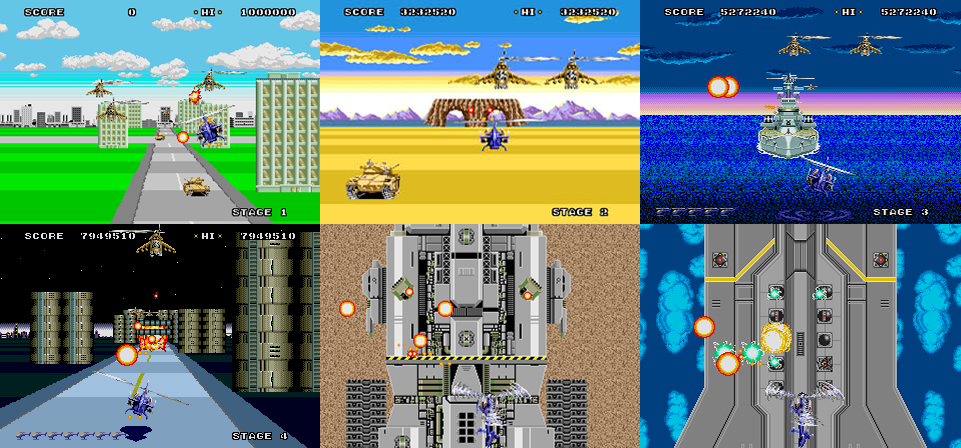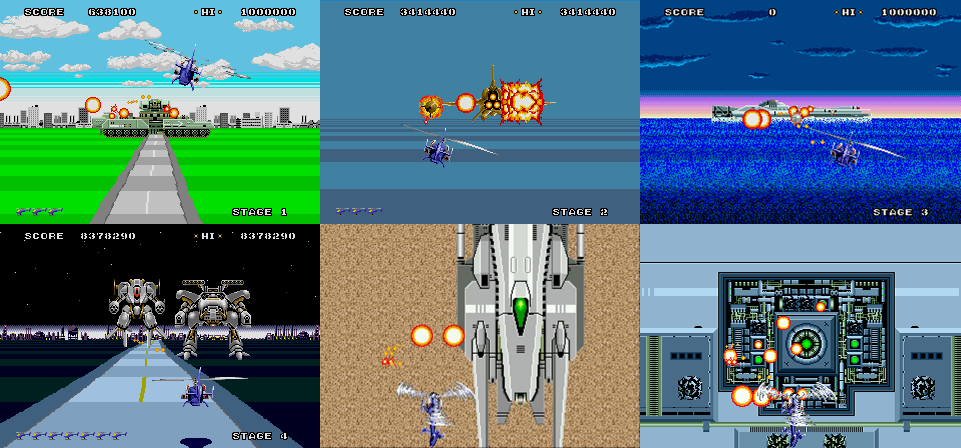It’s been almost 25 years since the Mega Drive first hit the store shelves in Japan. Back in the day, it was a 16-bit-powerhouse, whose board and processing power promised arcade-style hits in your own living room. Sega, back then a big player in the arcade game market itself, certainly banked on that strength when releasing its three launch titles for the system. One was a direct port of a current arcade game (Altered Beast), the other a follow-up to a beloved third-person shooter (Space Harrier II). The third launch title was supposed to be an overhauled home version of an arcade hit, famous for its great scaling effects. Super Thunder Blade, as that game was called, promised to deliver the frantic helicopter action its arcade predecessor Thunder Blade made famous.
To what effect? Well, here at this very site, the port had received a glowing review, stated to be a 10-out-of-10 game with impressive technology and gameplay – for its time. Reactions to that were… well, not very favorable. In fact, others in turn outright hate the game, even going so far as to calling the Genesis version a horrible mess and tossing it into the “worst ever” category. Where are these two opinions coming from, what are their angles, and in what way can the title be compared to its arcade predecessor? More importantly, is it able to stand on its own? Let’s have another look at one of the earliest Genesis games to hit the shelves and see how well this launch title is able to showcase the console’s strengths.
Blasting Off into Arcade-Style Action
First of all, Super Thunder Blade certainly takes its cues from the arcade predecessor: It is very short (only four stages), yet tough, as you practically get showered with enemies from early on. Each level is also set in an environment similar to Thunder Blade. The first stage is a somewhat urban battlefield, the second takes place in a desert filled with rock formations, the third takes us over open water, and the game concludes in an industrial setting. So Sega definitely tried to offer some familiarity for fans of the Arcade game.
So much for the obvious parallels. Now to the conversion: Thunder Blade impressed arcade goers with its smooth scaling effects, switching almost seamlessly between top-down shooting stages and a third-person perspectives somewhat akin to Space Harrier or After Burner. Unfortunately, scaling is not one of the Mega Drives stronger suits. The programmers responsible for the port tried to circumvent the issue somewhat. While the arcade version starts every level in a top-down shooting section, the Mega Drive instead presents us with a cut scene launch sequence, that immediately segues into the third-person shooting action. The top-down sections only return for the boss fights, where the level design allows the player to take a short breather from the shooting action while big battle stations slowly enter the screen. It’s a cheap trick, but admittedly it serves its purpose. When compared to the third-person shooting stages, the top-down boss fights seem a bit lackluster though, as all four of them play out relatively identical: swerve from left to right and try out to take as many shooting platforms as possible on that great grey mass underneath you.
Click the image to see the stages!
Hard on the Hardware
Since the console hardware was weaker than the Sega X-Board used in the arcades, Super Thunder Blade isn’t able to showcase as many objects on screen. The developers thus decided to concentrate on the opponents and treated the rest of the level decorations more like set dressing. Unfortunately, this leads to some very boring level design. For example, the first stage set in an urban environment sports only the same white building block over and over again. The third stage even entirely omits the swampy bushlands of the arcade game, opting instead for a battle over open water – easier on the processor, sure, but also very uninspired. It helps with the shooting though, as the movement of your helicopter is adequately smooth, allowing you to avoid the heavy incoming fire and the enemies darting towards you.
Even with all these cuts and tricks, he lack of proper scrolling ability constantly rears its ugly head. Environmental objects don’t zoom smoothly in, but choppily jump towards the player. In the first stage this is just a little annoying, as the sketchy animation heavily distracts from that of the opponents heading towards you. Things get worse doing the second stage, were the player is required to not only concentrate on the enemy, but also avoid rock formations blocking the way – the choppy scrolling makes it very hard to properly judge the distance, which leads to many accidental crashes. The third stage with its total lack of any environmental obstacles therefore is much easier, and comes as a big relief.
To make up for the missing introductory bits and lack of environmental diversity, Super Thunder Blade offers something not present in the arcade game: mid-level mini-bosses. Those are fought in the usual third person view, prompting you to avoid their incoming fire while carefully trying to take them out. Given the lack of diversity in the visual department, these mini-boss fights serve as a welcome distraction.
Since a launch title should now only showcase the graphical abilities of a new console, it’s worth paying attention to the sound department as well. Unfortunately, what we get here is a very mixed bag. The sound effects are grainy and distorted, to a point that when many explosions occur, what you get to hear comes off as a constant string of white noise. On the other hand, the background music isn’t bad. While not exactly amongst the most catchy tunes within the Mega Drive library, the soundtrack gives a good early impression of what the console was aurally capable of. There would still have been some room for improvement, but for a 1988/1989 home console game the music is pretty good.
Click the image to see the bosses!
Launch Issues
Overall, I must sadly admit that when compared to the other launch titles, Super Thunder Blade is the weakest of the bunch. Altered Beast is better in showing off what the Mega Drive was graphically capable off, while Space Harrier II allows for a slightly smoother gameplay. The choppy scrolling is annoying and heavily distracts from what is otherwise some decent shooting action. Trying to work around the hardware shortcomings of the home console when compared to the arcade game was a smart move, but what Super Thunder Blade delivers isn’t enough. Also, while the game is hard, four stages also mean that once you have the level patterns down, you’ll practically blast through them in no time, leaving little to no room for any replay factor. The music’s okay though, and if you’re able to look past the scrolling issues you’ll find some entertainment in the frantic shooting action.
Super Thunder Blade is not horrible, but the short length combined with choppy zooming and a rather poor utilization of the available color palette definitely result in a below-average game, even for an early Mega Drive title. If you’re a fan of early arcade ports in the Genesis library, I’d suggest taking a look at Altered Beast, Ghouls ‘N Ghosts, Afterburner II or the excellent conversion of Strider instead, as those do a far better job in showcasing what the new 16-bit home console could pull off early on.
Some images courtesy of 1up Games.



Say what you want about it, but this has to be one of the worst games on the system. Space Harrier is infinitely better than this game in virtually every aspect. How they released those two side by side and didn’t realize that one is a complete turd is beyond me.
oh come on its much better than you say it is, you want a horrible genesis game? try shaq fu or back to the future 3 or night mare circus